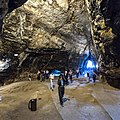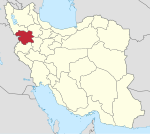Karaftu caves
The Greek inscription found at the cave ensemble;
"ʿĒraklēs [ʾenth]ade katoikei, mēthen eiselthoi kakon".
"Herakles resides here, nothing evil may enter"

The Karaftu caves[a] (Persian: کرفتو,Kurdish: کەرەفتوو) are an ensemble of artificially cut rock chambers located between Saqqez and Divandarreh, Kurdistan Province, Iran. The cave complex dates back to the 3rd or 4th century BC and is of major importance due to its Greek inscription; "one of the very few examples preserved in situ" in Iran.[1]
Alongside the Bisotun Herakles, it represents one of the only extant Seleucid rock-cut artworks.
The rock-cut cave complex dates to the Seleucid era, and likely served as a Seleucid garrison.[2]
Notes[]
- ^ Also spelled "Karafto".
References[]
- ^ Gall, Hubertus von (2010). "KARAFTO CAVES". Encyclopaedia Iranica, Vol. XV, Fasc. 5. pp. 533–536.
- ^ Canepa, Matthew P. (2018). The Iranian Expanse: Transforming Royal Identity through Architecture, Landscape, and the Built Environment, 550 BCE–642 CE. University of California Press. p. 186. ISBN 978-0520964365.
Coordinates: 36°16′N 46°51′E / 36.267°N 46.850°E
Categories:
- Iranian history stubs
- Kurdistan stubs
- Ancient Greek world stubs
- Populated places in Kurdistan Province
- Landforms of Kurdistan Province
- Caves of Iran
- Greek inscriptions
- Seleucid Empire











